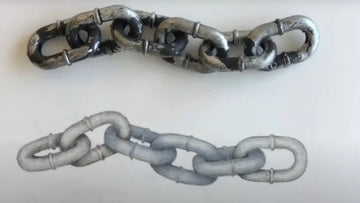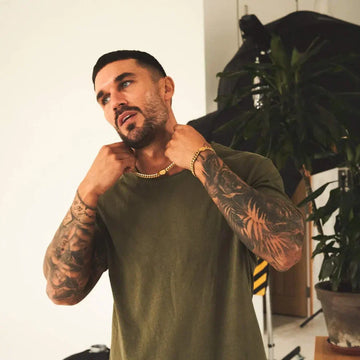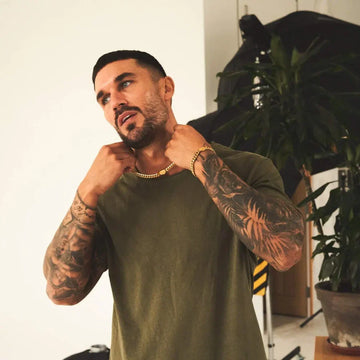In drawing, details often make the difference. Cuban link chains are known for their heavy, sturdy style and are a popular element in jewelry design. If you want to learn how to draw a Cuban link chain, this article will provide detailed steps to help you capture the essence of this unique design in your drawing.
1. Understand the structure of a Cuban link chain
The design of a Cuban link chain is distinctive, with each link intertwined to create a rounded and three-dimensional appearance. The first step in drawing an accurate Cuban link is to understand its basic structure. Each link resembles an oval and is tightly connected to the others. When drawing, ensure that the links maintain consistent proportions with each other to achieve a realistic look.
Steps:
Start by drawing a basic oval link, which is the basic unit of a Cuban link.
Make sure that each link is the same size by adjusting the length of the oval.
Draw the next link in turn so that it partially overlaps the previous link.
When drawing a chain, it is key to pay attention to the arrangement of the links. The tightness and continuity of the chain can reflect the solidity of the Cuban chain.

2. Master the correct angle and perspective
The three-dimensionality and angle of the chain are crucial. To make your Cuban chain appear more realistic, you need to master maintaining the continuity of the chain from various perspectives. Perspective changes will impact the distance and shape between the links, particularly when the chain is bent.
Steps:
First determine the direction and position of the chain in the picture, and gently draw the center line of the chain.
According to the principle of perspective, the links in the distance will appear smaller, and the links in the near will appear larger.
As the chain bends, pay attention to the natural angle of the links and keep each link aligned.
Perspective is a very important part of painting, especially when drawing complex objects like Cuban chains. Good perspective skills can make your work more three-dimensional and realistic.
3. Add shadows and brightness
The unique texture of the Cuban chain primarily derives from the luster and shadow effects of the metal. To give the chain a heavy and textured appearance, proper light and shadow processing is essential. Metal objects typically exhibit pronounced highlights under a light source, while the concave sections of the chain create shadows.
Steps:
Determine the position of the light source, which usually comes from above or from the side.Use white or an eraser to gently rub out the bright surface in the highlight area of the chain.Use a dark pencil or shading tool to darken the shadows at the joints and backlit sides of the chain to highlight the three-dimensional sense of the chain links.This contrast of light and shadow will not only make your Cuban chain more vivid, but also make it look as shiny as real metal.

4. Enrich details and add texture
After sketching the basic light, shadow, and structure, you can enhance the realism of the piece by adding surface texture to the chain. Metal chains typically have slight scratches or reflective effects, and these details can be represented through delicate lines.
Steps:
Use fine lines on the surface of the chain to express the texture of the metal. The lines should be drawn according to the curvature and light and shadow of the chain.Use slight short lines or dots to express the small reflective effects on the metal surface.The texture can be slightly deepened in the shadow part to highlight the three-dimensional sense of the Cuban chain.
The depiction of details does not need to be too complicated, but it must be coordinated with the overall light and shadow, so that it can be more natural visually.

5. Check the proportions and overall effect
The last step in drawing a Cuban chain is to check your work as a whole to ensure that the proportions of the various parts of the chain are reasonable, and the structure and details are consistent. At the same time, make appropriate adjustments to make the position of the chain more coordinated in the picture. You can use a ruler or digital tools to measure and adjust the alignment of each part.
Steps:
Check that each link of the chain is arranged equidistantly and of the same size as a whole.If you find that the light and shadow of some parts of the chain are not natural enough, you can make fine adjustments.Make sure the bends and perspective effects of the chain are as expected, so that it looks natural and smooth.After completing these steps, your Cuban chain painting is basically completed. With reasonable light and shadow processing and detailed depiction, the chain should look real and textured.
Summary
The key to drawing a Cuban chain lies in mastering structure, light and shadow, and details. With these basic techniques, both beginners and experienced artists can create a perfect Cuban link chain through consistent practice. To further enhance your skills, try experimenting with different angles and lighting effects, or incorporate creative design elements.
Whether it's a simple sketch or a complex jewelry design, learning how to draw a Cuban link chain is an essential skill. The next time you design a chain, remember to use these techniques to add vibrancy to your work!
Ultimately, mastering the techniques of drawing a Cuban link chain will not only enhance your artistic abilities but also distinguish you in jewelry design.














































